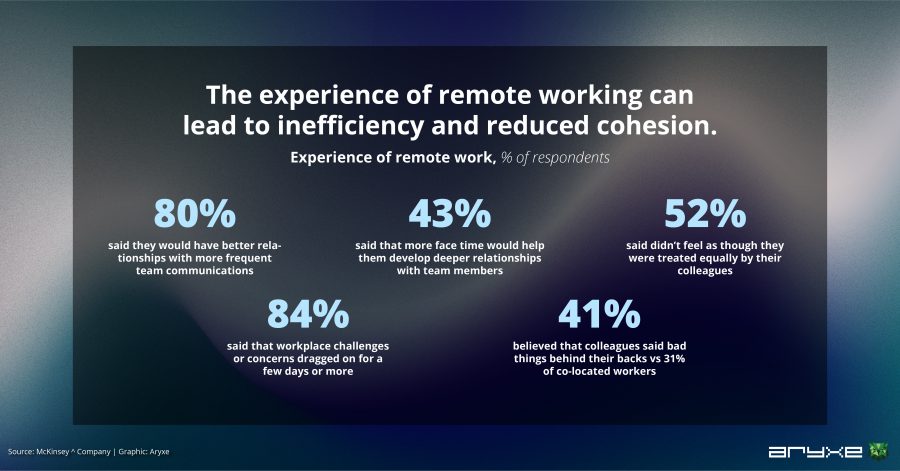Staying Agile – Part 4/4
9 min read

9 min read

by Aleksandra Stamatović
Covid-19 has created an extreme situation in which most workers were required to change the way they work; for many workers, that meant working from their homes.
Agile teams are typically well-equipped to deal with periods of disruption, thanks to their ability to adapt to the fast-changing dynamic in business priorities, digitization, and disruptive tech. However, the sudden shift to remote working has challenged the ideal approach to managing agile teams. Typically, agile teams are co-located – they are closely tied, allowing them to maintain frequent contact, simplify problem-solving, prompt communication, and facilitate fast-paced decision-making.
And although we can tell from experience that agile teams that have worked remotely since the very start can be equally effective as those working from the same office, this abrupt transition of co-located teams to a 100% remote approach could pose a significant risk to their cohesion and efficiency. Also, a team relying on traditional project management working remotely may struggle with their transition to agile without having that co-located setup in the first place. So, let’s talk about the ways to make agile work for remote teams.
In March 2020, a survey was conducted to verify how agile team members dealt with the shift to remote work and the main problems they were facing. Take a look at their responses:

Note that this report results from a survey conducted early in the coronavirus pandemic. Plenty of workers who were caught off guard by the transition to remote work back then have shared a negative stance toward remote work but have had a change of heart after having some time to adapt to it.
The good news is that even though there’s a lot of work to be done to make agile teams transition to remote work as painless as possible, it can still be done. With all the tech available, the transition can be seamless, provided those managing it put in a bit of time and effort to think everything through.
I have been a remote worker since way before the pandemic, so the remote work wave that began in early 2020 for others was already a regular part of my everyday life. Joining Aryxe, I was one of their first fully remote workers, as the team was working from an office before the pandemic. We teamed up to implement Scrum into our non-software development teams at the beginning of 2022, so in a way, our team was already quite used to working remotely, and the transition to agile project management wasn’t quite so much of a shock. And yet, we have a few tricks to share with those who may make up their mind and go agile.
We’re nearing the end of 2022, and although we seldom talk about coronavirus now, many organizations have decided to keep working remotely, thus lowering the second largest corporate expense, right after labor. This is why it’s paramount to remember the learnings and lean onto best practices from this extreme situation many organizations faced to create a model for the future where a higher percentage of the workforce is likely to be comprised of remote workers.
In this piece, I’ll focus on a few actions organizations and agile leaders can take to support their team members and company culture while recalibrating the processes.
Let’s start by exploring some of the many ways you can support the people and culture of your remote agile team by creating an environment where collaboration and communication are easy and natural.
Remote work requires agile teams to rethink how they organize their work and communicate with each other. The lack of physical proximity means that agile teams need better tools, processes, and practices for effective collaboration and communication. In addition, in the absence of day-to-day interaction, agile teams must be more thoughtful about establishing patterns of communication that feel natural and productive over time.
Leading an agile team transition into remote work isn’t easy, as mistakes you make by overlooking your team members’ group and individual needs could make or break the transition. So, remember that this is not the right time to skip steps or simply rely on your team’s skills and seniority. Instead, this is your chance to ensure the team has everything they need to keep working as productively as they usually would while having their teammates across the table. Take this time to evaluate the most effective tools you can use to support your teams’ remote work, rework current processes to adjust them to the new working environment, and keep a close eye on the team’s morale.
Even though your team is not co-located anymore, it is the organization’s responsibility to ensure they still feel safe sharing information with each other. This safety is often provided by mutual respect and trust between team members. Agile leads should preserve this trust through clear communication and strong interpersonal relationships. The absence of face-to-face interaction can challenge remote workers, who easily struggle to establish rapport with each other.
In a remote-work environment, teams must make a conscious effort to be tactful, polite, and social to feel just as safe contributing while working remotely as they would in person. So think outside the box and introduce a virtual coffee break event or a happy hour. Pin down a 30-minute window for your team members to get together and talk about whatever they want – other than work – just like they usually would while hanging out by the water cooler or in the corporate canteen. You can run a survey and ask your team members to brainstorm activities they would like to engage in with their team members in a remote setting. Fun activities are a helpful way to shape a shared experience virtually, help your team members bond, and form strong rapports, which will, in turn, help them work better together.
Continuous growth and development of each team member are significant in any agile environment. But unfortunately, this is another piece of the puzzle organizations tend to neglect in a remote setup, which will soon show its effects on your team’s efficiency and productivity if you fall into the trap.
If anything, an organization that has just gone remote should focus primarily on growth opportunities for the team members. A sense of uncertainty for employees across the globe painted the shift to remote driven by Covid. Investing in your teams’ professional development will put their minds at ease and show your intention to keep working in the same direction as you normally would in the traditional, co-located setup.
There are plenty of paid and free courses where you can encourage your teammates to explore their areas of expertise and tap into new ones. Piggybacking on the previous section, you could join the two by creating a dedicated channel for employees to share courses, certifications, and resources they find interesting for the rest of the team to check out.
In an agile team, it’s crucial to have everyone on the same page. Here a team works as one, and if there’s even just one team member out of sync, you may as well wave goodbye to cohesion. When decisions are being made across the broader organization, there needs to be a system in place to ensure everyone gets the memo. There can never be too much communication about the state of the business and what matters most. I can’t tell you whether to put an extra 5-minute window into your Daily Standup for such updates or to do something entirely different – you’ll have to come up with something that works for your team. I would highly recommend, on any occasion where you are trying to make a decision that will impact the way the team works, to simply run it by them. Get their feedback, see if they have a better idea, and choose whatever option you all agree with.
Keeping the meetings short and focused is one of the staples of any agile approach. But, for some reason, online meetings can quickly turn into marathon calls where topics seem never to stop piling up, and this can easily ruin your teams’ efficiency and agility. Therefore, preparation is the most critical part of your online meetings. In addition, having an agenda for the meeting available to all participants is indispensable. And, if you want to go a step further, defining and publicizing the dedicated timebox alongside all the listed items on the agenda will make everyone’s lives much easier.
Put yourself in your team member’s shoes. If they receive an invite for a call without an agenda, they are going to a meeting where they don’t know what will be the critical points of discussion, they have no clue how long the meeting may last, and they won’t know what action items they may end up with after the call. The lack of upfront information will make it impossible for them to plan their activities for the day and, in turn, affect their efficiency and productivity.
Agile development saw a tremendous spike in 2021, increasing from 37% to 86% of teams in the software industry, thus leading to a 232% increase YoY, according to Digital.ai. The growth in non-IT industries was as substantial, with agile adoption doubling YoY. As this is the last part of our 4-piece series, we don’t need to stress again how helpful and valuable the implementation of an agile approach can be for an organization – if done tactfully. That’s why we chose to close this down precisely with a topic that relates to the organizations that already have an agile approach in place and the ones who might be considering it.
Our teams have seen significant improvements in employee satisfaction, faster delivery times, and an overall spike in quality and productivity. Still, we’re aware that the journey doesn’t stop here as we continue to grow, develop and learn from experience.
If your organization happens to be considering the transition to agile but you’re not sure where to start, stay tuned for more resources on this topic that we’ll be sharing in 2023.